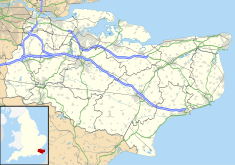Lydd Guildhall
| Lydd Guildhall | |
|---|---|
 Lydd Guildhall | |
| Location | High Street, Lydd |
| Coordinates | 50°57′04″N 0°54′19″E / 50.9512°N 0.9054°E |
| Built | 1792 |
| Architectural style(s) | Neoclassical style |
Listed Building – Grade II | |
| Official name | The Guild Hall |
| Designated | 28 November 1950 |
| Reference no. | 1338208 |
Lydd Guildhall, also known as Lydd Town Hall[1] and the Lydd Common House,[2] is a municipal building in the High Street, Lydd, Kent, England. The structure, which accommodates the offices and meeting place of Lydd Town Council, is a Grade II listed building.[3]
History
[edit]The building was designed in the neoclassical style, built in red brick and was completed in around 1792.[4][5] Re-faced in the early 19th century, it featured six openings on the ground floor, all flanked by pilasters supporting brick voussoirs. The first floor was fenestrated by five sash windows and surmounted by a cornice with a tiled roof above. Internally, the principal rooms were a market hall on the ground floor, an assembly room on the first floor and a series of prison cells in the basement. From 1830, the prison cells were only used as a temporary lock-up for petty criminals.[6]
The building was a regular venue for coroners' court hearings:[7][8] these hearings included the inquest into the deaths of 293 people who drowned, when the full-rigged ship, Northfleet, sank in the English Channel in January 1873.[9][10]
The borough council, which had met in the council chamber, was reformed under the Municipal Corporations Act 1883.[11] Fund raising events held in the guildhall included a function in support of Salute the Soldier Week in March 1944 during the Second World War.[1] A colourful piece of calligraphy by Irene Wellington, listing all the bailiffs of the borough since ancient times, was installed in the guildhall in 1973.[12][13][14]
The building continued to serve as the meeting place of the borough council for much of the 20th century,[15] but ceased to be local seat of government when the enlarged Folkestone and Hythe District Council was formed in 1974.[16] However, it subsequently became the meeting place of Lydd Town Council.[17]
References
[edit]- ^ a b Carpenter, Edward (1999). Romney Marsh at war. Sutton. p. 118. ISBN 978-0750922357.
Town Hall, Lydd , Kent to the people of Lydd , Dungeness & Greatstone. A little more than a year ago, we held our Salute the Soldier Week.
- ^ Lydd Records. Vol. 13. Archaeologia Cantiana. 1880. p. 252.
- ^ Historic England. "The Guild Hall (1338208)". National Heritage List for England. Retrieved 10 September 2023.
- ^ "Lydd Gaol". Prison History. Retrieved 9 September 2023.
- ^ Neild, James (1812). The State of Prisons of England, Scotland and Wales. London: John Nichols and Son. p. 362. ISBN 978-1108036993.
Lydd. Kent. The Town Gaol...This Prison, built in 1792, is under the Town-Hall
- ^ Appendix to the Second Report on County Rates. House of Commons. 1836. p. 73.
- ^ Report of the Commissioners Appointed to Inquire Into Municipal Corporations Not Subject to the Municipal Corporations Acts. House of Commons. 1880. p. 72.
- ^ "Chatham Man Drowned off Ramsgate". Kent Messenger. 6 November 1926. Retrieved 10 September 2023.
- ^ The Loss of the Ship "Northfleet". Waterlow and Sons. 1873. p. 123. ISBN 978-3382817602.
- ^ "Disaster off Dungeness" (PDF). The Journal of The Kilvert Society. 1 March 2001. p. 13. Retrieved 10 September 2023.
- ^ Municipal Corporations Act 1883 (46 & 46 Vict. Ch. 18) (PDF). 1883. Retrieved 26 March 2023.
- ^ "Wellington, Irene". Social Networks and Archival Context. Retrieved 10 September 2023.
- ^ "Findings in the calligraphic work of Irene Wellington". Patricia Lovett. Retrieved 10 September 2023.
- ^ "Regional Day". Cinque Port Scribes. 2005. Retrieved 10 September 2023.
- ^ "No. 45077". The London Gazette. 10 April 1970. p. 4122.
- ^ Local Government Act 1972. 1972 c.70. The Stationery Office Ltd. 1997. ISBN 0-10-547072-4.
- ^ "Welcome". Lydd Town Council. Retrieved 10 September 2023.

